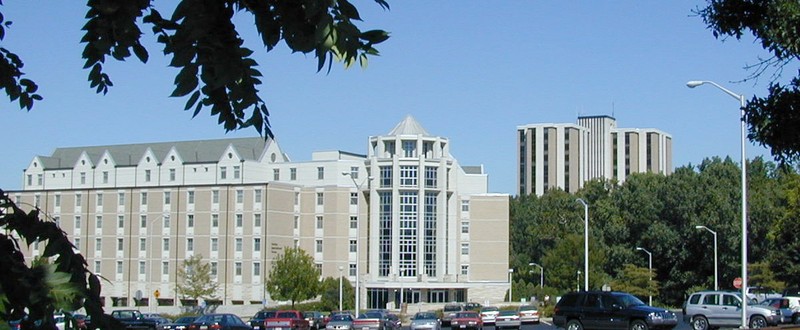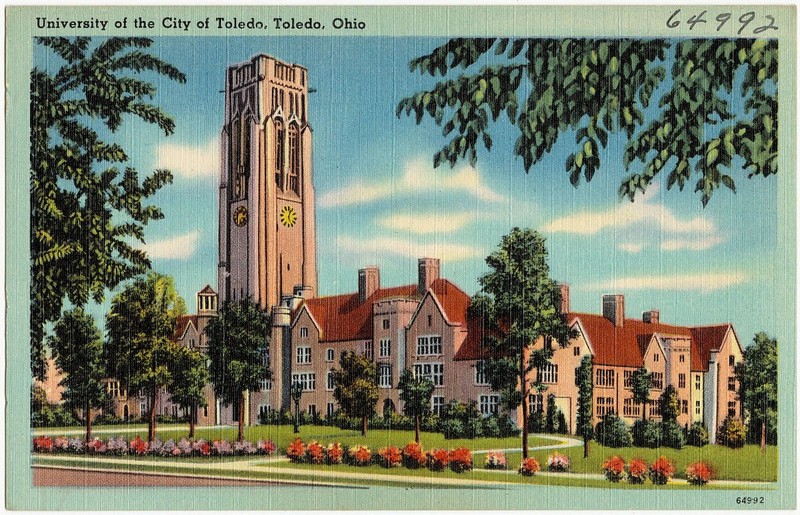University Hall; University of Toledo
Introduction
Text-to-speech Audio
Images
University Hall (built 1931)

Dorms, including the Horton International House, named after Dr. Frank Horton, the 13th President of The University of Toledo.

An undated postcard of the University of Toledo.

Backstory and Context
Text-to-speech Audio
Jesup Wakeman Scott envisioned Toledo as a future world center of commerce. To help the city achieve this goal, Scott donated 160 acres of land for a university. The Toledo University of Arts and Trades was incorporated on October 12, 1872, and held its first classes in the basement of the Unitarian Church basement on January 14, 1875. Scott’s dream appeared to meet its end when the university closed due to financial trouble in 1878, but the story did not end there.
On January 8, 1884, the university’s assets were taken over by the city of Toledo. A new tax was used to fund the university’s return as the Toledo Manual Training School later that year in the Central High School. Students were required to be at least thirteen years of age and, starting in 1886, the school accepted female students in addition to males.
Subjects at the Training School ranged from woodworking to housekeeping. In 1904, the school began an affiliation with the Toledo Medical College. During the 1910s and 1920s, it added a College of Arts and Sciences, College of Commerce and Industry, and College of Education. These additional degrees and expanded extracurricular activities led to an increase in enrollment.
After the closure of the Medical College in 1914, the Manual Training School replaced the medical school with a College of Pharmacy. That same year, the college moved to the corner of 11th and Illinois Streets and changed its name to Toledo University. The university also created several extracurricular activities, including the first season of football in 1917. The institution also focussed more on baccalaureate degrees than graduate degrees to attract a larger student body. After World War I, enrollment grew rapidly leading to the decision to build a new campus. University Hall became the center of this campus when it opened in 1931 and inspired the completion of additional buildings that mirrored its architecture and reflected the goal of boosters and administrators to create one of the largest municipally-funded colleges in the United States.
The University of Toledo changed from a municipal university to a state-funded one on July 6, 1967. This allowed the university to access state revenue which supported the creation of new programs and the construction of additional buildings. The university now boasts eight colleges, over 20,000 students, and 450 acres of land.
Sources
Hickerson, Frank R. The Tower Builders; the Centennial Story of the University of Toledo. University of Toledo Press, 1972.
University of Toledo. Ohio History Central. Accessed October 19, 2018. http://www.ohiohistorycentral.org/w/University_of_Toledo.
Horton International House. The University of Toledo. Accessed October 19, 2018. http://www.utoledo.edu/studentaffairs/reslife/ResidenceHalls/InternationalHouse.html. Photo source.
Mactropy. U-of toledo ihouse. Wikimedia. May 22, 2005. Accessed October 19, 2018. https://commons.wikimedia.org/wiki/File:U-of_toledo_ihouse.jpg. Photo source.
Mactropy. University Hall, University of Toledo. Wikimedia. August 12, 2002. Accessed October 19, 2018. https://commons.wikimedia.org/wiki/File:University_Hall,_University_of_Toledo.jpg. Photo source.
